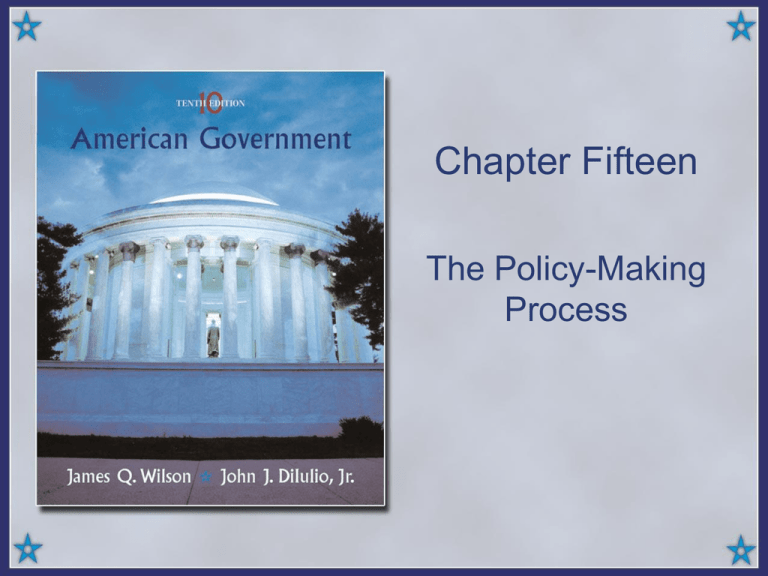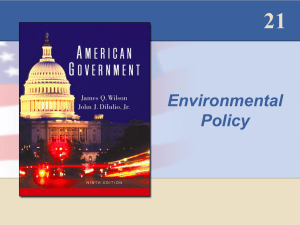
Chapter Fifteen
The Policy-Making
Process
Setting the Agenda
• The political agenda: deciding what to
make policy about
• The current political agenda includes taxes,
energy, welfare, and civil rights
• Shared beliefs determine what is legitimate
for the government to do
Copyright © Houghton Mifflin Company. All rights reserved.
17 | 2
Scope of Government Action
• Government always gets larger
• People generally believe that government
should continue to do what it is doing now
• Changes in attitudes and events tend to
increase government activities
• Government growth cannot be attributed to
one political party
Copyright © Houghton Mifflin Company. All rights reserved.
17 | 3
The Influence of Institutions
• The courts make decisions that force action
by other branches: e.g. school
desegregation, abortion
• The bureaucracy is a source of innovation
and forms alliances with senators and staff
• The Senate is a source of presidential
candidates with new ideas
Copyright © Houghton Mifflin Company. All rights reserved.
17 | 4
Other Influences
• Groups may react to a sense of relative
deprivation
• The media helps place issues on the
political agenda
• The national government may later adopt
ideas pioneered by the states
Copyright © Houghton Mifflin Company. All rights reserved.
17 | 5
Costs, Benefits, and Policy
• Cost: any burden, monetary or non-monetary,
that some people must, or expect, to bear from
the policy
• Benefit: any satisfaction, monetary or nonmonetary, that some people must, or expect, to
receive from the policy
• Politics is a process of settling disputes over who
benefits/pays and who ought to benefit/pay
Copyright © Houghton Mifflin Company. All rights reserved.
17 | 6
Figure 17.1: A Way of Classifying and
Explaining the Politics of Different Policy
Issues
Copyright © Houghton Mifflin Company. All rights reserved.
17 | 7
Kinds of Politics
• Majoritarian politics: distributed benefits,
distributed costs
• Interest group politics: concentrated
benefits, concentrated costs
• Client politics: concentrated benefits,
distributed costs
• Entrepreneurial politics: distributed
benefits, concentrated costs
Copyright © Houghton Mifflin Company. All rights reserved.
17 | 8
Majoritarian Politics
• Example: Antitrust legislation in 1890s was
vague with no specific enforcement agency
• During the reform era, politicians and
business leaders committed to a strong
antitrust policy
• Enforcement was determined primarily by
the ideology and personal convictions of
the current presidential administration
Copyright © Houghton Mifflin Company. All rights reserved.
17 | 9
Interest Group Politics
• Organized interest groups are powerful
when regulatory policies confer benefits on
one organized group and costs on another
equally organized group
• Example: In 1935 labor unions sought
government protection for their rights;
business firms were in opposition
Copyright © Houghton Mifflin Company. All rights reserved.
17 | 10
Client Politics
• “Agency capture” is likely when benefits are
focused and costs are dispersed—an
agency is created to serve a group’s needs
• Example: National regulation of milk
industry, sugar production, merchant
shipping
• The struggle to sustain benefits depends
on insider politics
Copyright © Houghton Mifflin Company. All rights reserved.
17 | 11
Entrepreneurial Politics
• Relies on entrepreneurs to galvanize public
opinion and mobilize congressional support
• Example: In the 1960s and 1970s a large
number of consumer and environmental
protection statutes passed (e.g., Clean Air
Act, Toxic Substance Control Act)
Copyright © Houghton Mifflin Company. All rights reserved.
17 | 12
Deregulation
• Example: airline fares, long distance
telephoning, trucking
• Deregulation is a challenge to iron triangles
and client politics
• It is based on the idea that governmental
regulation was bad in industries that could
be competitive
Copyright © Houghton Mifflin Company. All rights reserved.
17 | 13

